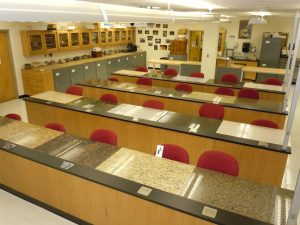Module 3. Petrology of Countertops
3.1 Overview of Countertop Project
3.1 Countertops Overview
Elizabeth A. Johnson; Sarah O'Reilly; and Eric Pyle

The Department of Geology and Environmental Science at James Madison University renovated our Mineralogy/Petrology classroom in 2012 (and moved them in 2018). Rather than put in standard lab counters, our department obtained leftover countertop materials from a nearby commercial supplier.
We have 10 different rocks, and created 2 desks from each rock type for a total of 20 desks in the classroom. These rocks are decidedly non-local, but should be widely available in home improvement stores and countertop dealers. We realized that professors and teachers around the country could have access to these rocks, and that our data and exercises for these samples could be useful to others! Thus, the countertop database was born.
It cost about $31 per square foot, plus the cost of labor, to install these countertops. This is roughly comparable to the cost of installing standard black chemical-resistant lab countertops. If you anticipate a classroom renovation in the future, it is definitely worth looking into the option of using stone.
Even if a renovation isn’t in your future, countertop and building stones are fun to use in the classroom, and certainly many others have developed exercises based on such materials (if you are one of these folks, please let us know and we’ll link to you!). You can likely get small samples or discards from building suppliers for little or no cost. We look forward to hearing about successful countertop experiences at other schools.
Learning Objectives
Learning Objectives
The learning objectives for this module are flexible and depend on the chosen assignment. These may include:
- Identify minerals in countertops; learn about Moh’s Hardness scale.
- Describe igneous rock textures and hypothesize about their origins during cooling.
- Review identification of minerals under the polarizing microscope
- Complete a petrographic description of a sample.
- Name rocks based on the IUGS classification diagrams.
- Plot and interpret tectonic discrimination diagrams using geochemical data.
- Calculate modal abundances of minerals using point counting.
- Determine plagioclase composition using the Michel-Levy method.
- Calculate temperature using feldspar thermometry.
References
Johnson, E.A., O’Reilly, S.K. and Pyle, E.J. (2012) A petrographic and geochemical database for countertops as a teaching resource. Geological Society of America Abstracts with Programs, 242-8. Poster
Media Attributions
- Countertops in Classroom © Elizabeth Johnson is licensed under a CC BY-NC-SA (Attribution NonCommercial ShareAlike) license

